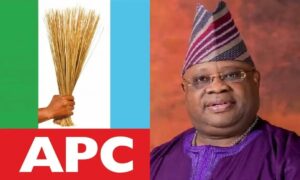Commercial banks borrow N9.97trn from CBN in seven months
By Kayode Tokede
Amid ease in economy, commercial banks in Nigeria borrowed N9.97trillion from the Central Bank of Nigeria (CBN) between January and July, Nigerian NewsDirect gathered from the apex bank.
Nigerian NewsDirect gathered that the ease of COVID-19 lockdown attributable to commercial and merchant banks aggressive borrowing from the apex bank lend to real sector.
The CBN financial data revealed that commercial and merchant banks, through the Standing Lending Facility (SLF), between January and July 2020, borrowed N5.34trillion.
This represents an increase of 86 per cent loan that commercial and merchant banks borrowed from the CBN in seven months in 2021.
The breakdown revealed that commercial and merchant banks in January borrowed N310.83billion from CBN and this figure increased to N612.94billion in February.
However, in March, commercial and merchant banks borrowings increased significantly to N4.6trillion, but drop to N2.48trillion in April.
It further dropped to N904.68billion in May. In addition, N621.67billion and N426.7billion were borrowed from CBN by commercial and merchant banks in June and July respectively.
From the data collected from the CBN website, commercial and merchant banks heavily borrowed from CBN through the SLF window to square-up their daily business operation this year.
The trend at the CBN’s SLF window showed more patronage as commercial banks thrive to meet the 65 per cent Loan to Deposit Ratio (LDR) policy.
SLF simply means commercial banks accessibility to funds from the CBN in order to carry out its day-to-day business activities.
The Monetary Policy Committee (MPC) in September 21, 2020 voted to reduce Monetary Policy Rate (MPR) to 11.5 per cent, applicable to SLF interest rate of 13.50 per cent.
Our correspondent gathered that commercial and merchant banks in prievious year, reduced borrowing from the apex bank amid COVID-19 lockdown, as they focused more on LDR deadline which mandated them to give soft credit to key sectors in the nation’s economy.
Analysts who spoke with Nigerian NewsDirect explained that weak deposit from banks’ customers led to increased borrowing from the CBN, stressing that economic factors also contributed.
They expressed that the opening up of the nation’s economy in 2021 impacted on increasing commercial and merchant banks lending to real sector, which is part of the CBN’s objectives to boost economy growth and drive credit access to real sector.
According to financial experts, although the data revealed that banks borrowed more funds from the regulator first six months of 2021, compared to 2020, most of those borrowings appeared to have come from small and mid-size banks experiencing liquidity problems.
Speaking with Nigerian NewsDirect, the Managing Director, Highcap Securities Limited, Mr. David Adnori affirmed that growing demands from commercial and merchant banks were responsible for hike in borrowing from CBN.
According to him, “the opening of the nation’s economy this year aided growth in banks’ borrowing from CBN. The demand for banks loans increased tremendously.
“When demand on banks’ loans increased significantly and banks don’t have depositors’ money to lend, they visit CBN to borrow from the SLF.
“The deposit by bank’s customers is insufficient to meet loans application by customers- reason why banks and merchant banks to access more funds.”
Also, a top official in a Tier-2 bank said that borrowing recently by commercial and merchant banks cover temporarily funding gaps.
He noted that the CBN has also increased its Cash Reserve Ratio (CRR) debits.
Under CRR, the banks have to hold a certain minimum amount of deposit as reserves with the CBN.
Top bank executives explained to our correspondent that liquidity problems with some banks, especially a few of the small and mid-size could be traced advanced loan to some oil and gas as well as power companies.
The Chief Executive Officer of one of the banks, who spoke to our correspondent, said, “The liquidity problems with the banks can be partly traced to legacy loans that arose as a result of the bank lending to oil and gas sector. Up till now, the balance sheets of some of the banks still have these loans.
The CBN has given them some kind of forbearance, but the challenge is that the loans impacted the banks badly.
Banks gave loans to power firms during the privatisation of the power sector.
“Government encouraged banks to give the loans but those loans later had problems. Then you had the recession that hit the country, the first in 25 years. That affected the banking sector. The big banks are surviving because of their size.
A Nigerian economist and professor, Akpan Ekpo, attributed the significant borrowing by commercial and merchant banks to increasing demand of liquidity from customers.
According to him, “The increasing borrowing by banks’ customer is normal and it is meant to rejig the nation’s economy.
“If banks failed to pay back, CBN deals with them through CRR debits.”
He, thus, questioned real sector banks to lending.
On this, he said, “We need to know if the lending from CBN by banks is going into agriculture, Oil & gas, among others. However, six months are too short to begin to access impact of banks borrowing from CBN.”
Analyst at PAC Holdings, Mr. Wole Adeyeye expressed that commercial and merchant banks have no other option than to borrow from the CBN to lend to real sector.
In his words, “In the first quarter of 2020, there was lockdown. Since the ease of the lockdown, CBN was working with banks to improve lending to real sector.
“Banks are actually giving out these funds to meet their daily obligation of lending to real sector. The aim of the CBN and banks is to enable people have access to credit facility. It is indirectly CBN’s giving banks this SLF to the people.
“It is like CBN improving productivity in the nation’s economy.




